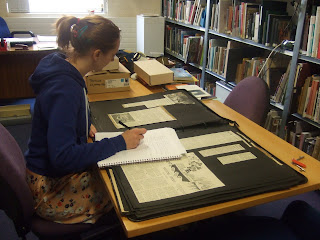NIVAL began cataloguing the very extensive KDW Archive in 2009 with the aim of creating an online finding-aid for the collection. At present this is a text-based catalogue but plans are underway to digitise a representative collection of the photographic documentation and to connect these with the paper records.
NIVAL’s target audience is inclusive and encompasses anyone with an interest in KDW and design in Ireland including third and fourth level researchers, academics, artists and designers, arts administrators, librarians and archivists, and the general public. With the development of web resources and online databases, NIVAL is increasingly able to satisfy users’ needs remotely, reaching a wider national and international audience.
KDW cataloguing project, Phase 1
In 2009, NIVAL began Phase I of the project with an appraisal of the KDW Archive, donated to the library by the Crafts Council of Ireland. The archive includes c.40 volumes of press material, 26 volumes of record sheets, and 10,000’s of photographic images documenting the craft and design products developed by the Workshops between 1963 and 1988. The appraisal involved the establishment of a project plan for managing the collection in several distinct but related stages, and the identification of logical archival series within the collection. This phase of the project was aided by a research grant from the Design History Society, U.K, and by funding from the national College of Art and Design, Dublin.
Phase 2 KDW cataloguing
Foreground - Theresa Reilly, MA Intern, background - Dr Una Walker
KDW cataloguing project, Phase 2
Phase 2 of the KDW project, entitled the Photographic Image Management Project, began in March 2010. Funded by the Heritage Council and the National College of Art and Design (NCAD), the aim of Phase 2 was to arrange, catalogue and preserve the unique collection of 10,000’s of photographic images produced by the KDW as both a promotional tool and documentary record of the work undertaken by the Workshops over their 25 year history. Phase 2 was concerned only with the photographic material for which there exists some form of text-based documentation that aids in the identification of the images.
The project was been carried out by NIVAL in collaboration with students on the MA in Design History and Material Culture programme at NCAD. Dr. Una Walker, Postdoctoral Researcher at NIVAL, managed the project with the assistance of Donna Romano, NIVAL Administrator. The project team included Seamus Gilna, Senior Cataloguer; Katie Blackwood, Roisin Sheridan and Renata Pekowska, NIVAL Assistants; Robert Bridge, NCAD I.T. Support; and seven postgraduate student volunteers.
Phase 3 KDW cataloguing
Katie Blackwood, NIVAL, preparing to input data on the KDW press clippings
KDW cataloguing project, Phase 3 - Overview
June – to October 2011
The aims of Phase 3 of the project are to catalogue
- 34 volumes of KDW press and publicity material to series and file levels
- 26 volumes of KDW record sheets which provide the most complete documentation available of all design jobs undertaken by KDW to series and file levels
- the photographic material for which no documentation exists (an estimated 600 files) to series and file levels
and
- to input the records to the web-based database which has been developed using a relational database based on ISAD(G) elements of description.
Cataloguing the KDW Archive is still underway but a sneak preview can be had on










